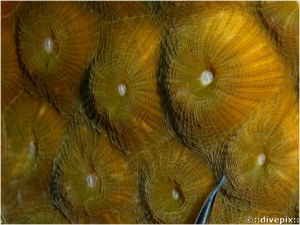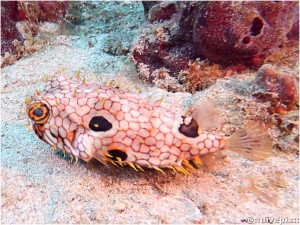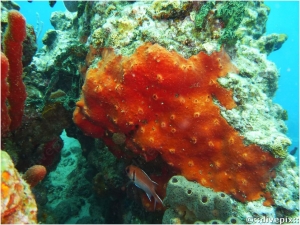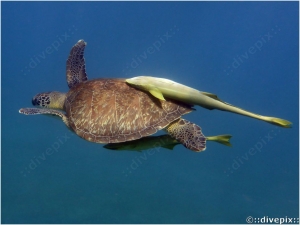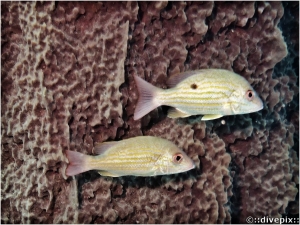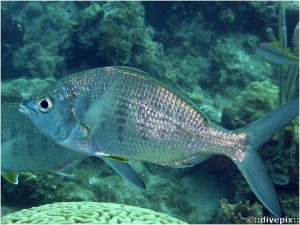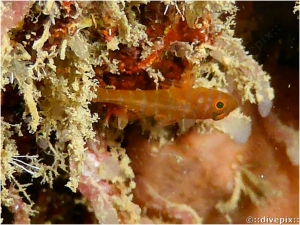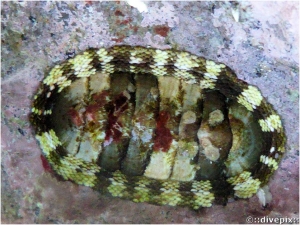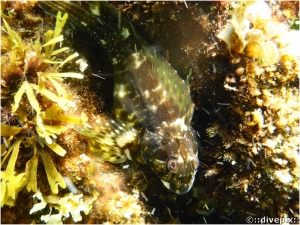




Eric H. Biass
Boulder Star Coral
| Aspect: |
Clusters of light brown to darker brown corallites forming encrusting plates and mounds (hence Montastraea = Mountainous in the former scientific designation) that can spread over several tens of centimetres. NOTE: The species was until recently known as Montastraea franksii. It is part of a group that includes another two variations known as Orbicella annularis (formerly Montastraea annularis) and Orbicella faveolata. All three belonged to the Faviidae family, but this has now also been renamed to Montastraeidae (in other words what used to be designation is now transferred to family name). This being said, the vernacular names in English and French have remained unchanged. |
| Population: | Common. |
| Notable feature: |
Detailed descriptions in the little available literature on the Montastaelidae family (formely Faviidae) is scarce and often contradictory. However, it appears that the Boulder Star Coral distiguishes itself from the Great Star Coral (q.v.) in having corallites that form less less prominent cones (in other words with lower-gradient side walls). Coloration (light brown most common around Ilets Pigeon) and bleaching depend on the nature or absence of zooxanthellae. Zooxanthellae are microscopic photosynthetic algae that live in symbiosis with corals. The latter provide shelter in exchange of which the zooxanthellae supply certain nutriments (including glucose and aminoacids relutling from photosynthesis) that enable them to eventually produce the calcium carbonate used to form their structure. When under stress - as happens with sudden temperature surges - coral expel their zooanthellae which causes them to lose their coloration in a phenomenon known as bleaching. |
| Environment: | Found depths of a few metres down to 40 metres. |
| Behaviour: | Polyps usually extend at night. |
Web Burrfish
| Aspect: | Compact light beige body with dark brown reticulated pattern that fades as it reaches the ventral area. Dark patches (almost black) on sides above and aft the pectoral fins, plus one surrounding the root of the small dorsal fin. Unlike other Porcupinefishes, spines (yellow) seem to remain permanently erect. |
| Population: | Uncommon. |
| Notable feature: | Like Briddled Burrfish (q.v.), the eye sclera is surrounded by dark spots, but in fewer numbers. |
| Environment: | Near bottom, around rock or coral boulders in not too deep waters (about 10-15 metres). |
| Behaviour: | Very weary. |
Orange Sieve Encrusting Sponge spp
| Aspect: | A bright orange spongy mass with numerous pin-hole incurent pores and larger raised excurrent craters. |
| Population: | Occasional. |
| Notable feature: | CAUTION: There is very little detailed literature on the species, hence spp annotation. |
| Environment: | Protected and recessed areas (which may explain rare visibility). |
| Behaviour: | - |
Yellow Sharksucker - Remora
| Aspect: |
Flatish yellow to light brown elongated body with faint thin white line running from snout to tail. Bright yellow fins and tailfin, yellow to light grey belly. NOTICE: This sharksucker variation does not appear to have been described, hence our unofficial "Yellow Sharksucker" designation |
| Population: | Seldom seen swimming around on its own. |
| Notable feature: | Flattened head top hosts a number of sucking patches to enable it to attach to larger fish - typically sharks, but also Jacks and turtles. Often seen attached belly up on the back of turtle shells. |
| Environment: | Usually stays stuck under carrier fishes with the purpose of catching food "left-overs" when the carrier fish catches a prey. |
| Behaviour: | Unafraid. |
Lane Snapper
| Aspect: |
Typical Snapper outline with long sloping forehead and pointed snout BUT: Juvenile: pale pink-silver body with light yellow horizontal lines, dark spot below dorsal fin and yellow ventral and anal fins. Incidentally the dark spot distinguishes it from the otherwise quite similar Mahogany Snapper (q.v.). Intermediate: A rarely observed intermediate phase seen in our title picture is devoid of black spot. Older specimens (not seen here): Boast a more resolutely silvery body with very faint horizontal lines, silvery fins and black dot below dorsal fin. |
| Population: | Common. |
| Notable feature: | Juveniles generally sport yellow ventral and anal fins as well as a slightly red dorsal fin edge - two features that tend to fade with age. |
| Environment: | Close to bottom, in not too deep waters (10 metres max.) |
| Behaviour: | Wary and difficult to approach. |
Yellowfin Mojarra
| Aspect: | Silver oblong body wiith somewhat elongated snout, yellow ventral fin. |
| Population: | Common. |
| Notable feature: | 6 or 7 faint bars run from dorsal fin and fade in ventral area, but above all yellow ventral fins distinguishes it from Flagfin Mojarra (q.v.). |
| Environment: | Usually found in quiet shallow waters, feeds on small invertebrates in the sand. |
| Behaviour: | Unlike wary Yellowfin Mjarra, easy to approach. |
Rusty Goby
Aspect:
| Rust coloured body with lighter (orange) coloured vertical bars and lighter eye surrounds. |
|
| Population: | Difficult to ascertain due to its environment. |
| Notable feature: | Prominent globular eyes. Often lives upside down. |
| Environment: | Caves and recesses. |
| Behaviour: | Remaining totally quiet is its best way of remaining unseen, but like all gobies will dart away if approached too closely. |
Staghorn Coral
Aspect:
| Form an entanglement of thin, sharp-tipped radially developing branches and sub-branches. Resembles a petrified giant spark. |
|
| Population: | Common. |
| Notable feature: |
Yellow to light brown. Round-section branches are covered in hard corallites, but tipped with a white corallite, which has nothing to do with coral bleaching disease. |
| Environment: | Relatively shallow waters down to about 20 metres, on sandy bottoms. |
| Behaviour: | . |
Fuzzy Chiton
| Aspect: | An elongated oval made up of an array of eight slightly overlapping shell plates surrounded by a grey/white and black coloured girdle. This flexible carapace protects the creeping animal's body. Thanks to its mantle, the animal can develop a solid grip on rocks. |
| Population: | Common. |
| Notable feature: | Curls up into a ball for protection if attacked. |
| Environment: | Usually found on shore rocks close to the interdidal line. They feed on algae and vegetals. |
| Behaviour: | - |
Molly Miller
| Aspect: | Green-brown, with light dotted sides transforming into lines toward the tail area. |
| Population: | Scarce (but also hides). |
| Notable feature: | Orange and white cirri Orange crest on "forehead" |
| Environment: | Shallow waters, near shore, sandy bottom. |
| Behaviour: | Shy, hides in recesses. |



